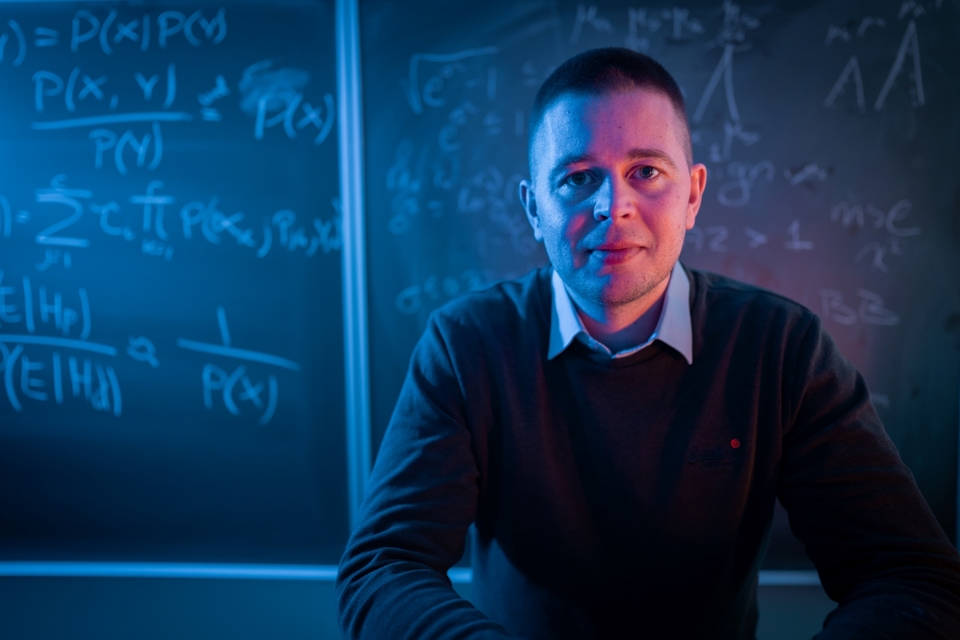By Lea Laursen Pasgaard and Jeannette Bylov, AAU Communication. Translated by LeeAnn Iovanni, AAU Communication. Photo and Video: Lasse Møller Badstue, AAU Communication
- When you know something – or can calculate something – that can help inform a trial and thus improve the basis for a conviction, then I think you have a duty to do so. Actually both as a researcher and as a private person.
These are the words of Mikkel Meyer Andersen, Associate Professor in the Department of Mathematical Sciences at Aalborg University (AAU). Partly because of the ground-breaking research on statistical models that he did with research colleagues, a verdict could be handed down in February in one of Norway's most publicized murder cases in recent times. The case concerns the murder of 17-year-old Birgitte Tengs, who in 1995 was found raped and killed on the island of Karmøy.
DNA material was found on the victim’s tights, but the technology was not sufficiently developed at the time to be used as evidence. In 2021, developments in the DNA area – including genealogy as a tool – led to Norwegian police arresting a 52-year-old Norwegian man for the murder.
Weighting the evidence
Along with his Australian colleague David Balling, Mikkel Meyer Andersen developed a mathematical model that helped the Norwegian police and the prosecution service calculate the number of possible perpetrators. Mikkel Meyer Andersen's calculations in the case show that the defendant's Y chromosome is very rare and that there is a high probability that DNA found on the victim's tights comes from the accused man. Mikkel Meyer Andersen stated in court that there is a 99 percent certainty that there can only be 18 or fewer men in the entire world who have the same Y profile as the defendant.
At the end of 2022, Mikkel Meyer Andersen was called as an expert witness in the trial, along with other experts from the Netherlands, Austria and England. The convicted man has appealed, and the case will go to trial again in the autumn. Therefore, the AAU researcher cannot comment on the specific case, but he has agreed to tell AAU Update about his research in general terms.
- My method can calculate how rare a DNA profile based on the Y chromosome (Y profile) is. If the Y profile is frequent – i.e. many men have it – there may be many individuals who left the biological material found at a crime scene. In other words, it is less incriminating for the suspect to have the Y profile – so do many others, says Mikkel Meyer Andersen.
He continues:
- But if the profile is rare, then the strength of the evidence (the Y profile) is greater – because then there are fewer individuals the biological material could come from. And when the other individuals also have to match other evidence, it is incriminating for the suspect to have a rare Y profile that matches the one found at a crime scene.
Mikkel Meyer Andersen was surprised when the Norwegian police reached out to him.
- Normally, I do research on and develop methods for use in court with a view to others using the methods. This was done, for example, with a method I developed with Poul Svante Eriksen of AAU and Niels Morling of the University of Copenhagen, which was used in Germany, Switzerland and Norway. I’ve never presented results from it in court, but others have. However, our second method was relatively new, and not many people have experience using it, he says.
Method with far-reaching perspectives
This is the first time DNA materials from Y chromosomes have been compared with such statistical calculations and used as evidence in a murder case in Norway. Mikkel Meyer Andersen and his colleagues' statistical calculations can potentially change the methods used in rape cases and murder cases around the world.
- The two models can be used in other homicide cases and sexual assault cases. And I hope and expect that their use will become even more widespread, says Mikkel Meyer Andersen and adds:
- The model we developed is based on mathematics that was done many years ago. Math we didn't know could be used in exactly this way. So it underscores once again the importance of foundational research in mathematics.

